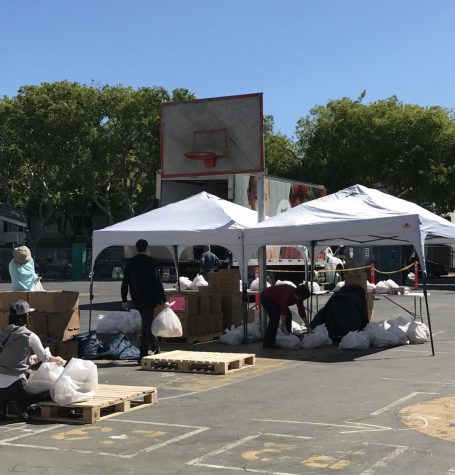Fighting food insecurity: Volunteering in the midst of the pandemic
The SF-Marin Food Bank
It’s Tuesday morning at 8 a.m., and the line for the food bank’s pop-up pantry at Cesar Chavez Elementary loops around the entire block. In the schoolyard, about 25 volunteers, including Lowell Peer Resources coordinator Adee Horn, walk from station to station of food, grabbing an assortment of different fruits and vegetables and filling large bags with them as they go. Topping off each bag with handfuls of potatoes and one large frozen pork loin, they tie them up and grab another bag, repeating the cycle until it’s time to go. Outside, more volunteers are working, handing out a grocery bag for each household. Even when Horn leaves, the line of people outside waiting for food still stretches far around the corner of the block.
These shifts at the food bank have become a regular part of Horn’s routine since SFUSD schools closed in March.
To assist the growing number of people in need of food due to unemployment or financial stress caused by the pandemic, the San Francisco-Marin Food Bank opened 25 emergency pop-up pantries all around San Francisco and Marin in March. With a pantry so close to her home in the Mission District, Horn volunteers every Tuesday, finding a way to serve her community during a time when very few can due to health risks, parental responsibilities, time constraints, and more. But while she and her fellow essential workers have built an atmosphere of positivity at the pantry, their work makes them acutely aware of the reasons they are all there — the drastic increase of people in need.
Horn first got into volunteering during the shelter-in-place through SFUSD. She received an email in early March calling for volunteers to staff libraries and recreation centers where they had expected children of essential workers to stay during the day. After it turned out that those services weren’t needed, SFUSD emailed yet again, this time with suggestions to volunteer at the SF-Marin Food Bank, which, having just established dozens of pop-up pantries in addition to running their regular warehouses, was in serious need of more volunteers. Horn answered the call to action because she could. “[Volunteering] just feels really important to me because I’m someone who gets paid right now… and because I’m healthy,” Horn said. “It allows me to be able to help, whereas [for] someone else who’s not getting paid and isn’t healthy, they don’t have the option to go volunteer.”
As an essential worker for the food bank, Horn has seen the negative effects of the shelter in place directive firsthand. At the pop-up pantry, she sees the large demand for food every week resulting from unemployment and various financial troubles. Thirty thousand more households receive their weekly groceries from the SF-Marin Food Bank than before the pandemic, according to their website. They also receive nine times more calls requesting food stamp application support than before and a 550 percent increase in visits to their online Food Locator tool, a multilingual service that helps people find their nearest pantry or sign up for food programs that can cater to their specific situations. According to Janna Cordeiro, the project manager at the San Francisco Wholesale Produce Market, 1 in 4 San Franciscans was already food insecure before the pandemic hit. “As this wears on, the food lines are longer and longer,” she said. While organizations like the school district and the food bank responded quickly to lessen the impact of the shelter-in-place directive on food security, both Cordeiro and Horn agree that the situation is still grim for many, like people who are unable to file for unemployment. And, while she has a stable income now, Horn knows there was a time in her life when this pandemic would have hit her hard, too, and she might have been one of the people lined up at Cesar Chavez. “I’ve waited tables in my life before I got into teaching, and at some restaurants, you can make a decent living waiting tables,” said Horn. “But now that’s gone, so [for] someone who’s been making a decent living waiting tables, they might be at the food bank.”
A lack of support for many during this time has made the holes in the food system even more prominent. While Cordeiro is familiar with the many ways people are battling food insecurity, like SF’s Right to Recover program and her own as a program manager, she acknowledges that it’s still not enough. “The biggest initial impact was that our system that we had in place to feed people was reliant on schools, nonprofits, and senior centers,” she said. According to her, over 50 percent of students in the San Francisco Unified School District qualify for free or reduced lunch, and many senior citizens were receiving their lunches from congregate meals at senior centers. With the pandemic, those places were shut down, leaving many wondering where their next meals will come from.
But it’s not all doom and gloom; in this time of need, many San Francisco residents have risen to the occasion, whether it be through their own organizations or taking the time to volunteer. For example, the SF Wholesale Produce Market has donated over 2 million pounds of food for those in need, and Cordeiro has been seeing others in the food industry take similar action. “Lots of people working really hard and doing amazing things — I see it everyday — using their own resources, working overtime, just rolling up their sleeves, but it’s a big challenge,” she said.

Being a teacher, this situation also makes Horn aware of what her students could be going through during these times, as she sees students just like them lining up for food every day. She recognizes the privilege she has compared to them. “I live in a house with two friends, and we’re all working — all of us are still getting paychecks — which is amazing, and we have enough space in our house so each one of us can be on a work call and not be in each other’s way,” Horn said. She knows her students are not as privileged. “I think about my students that live in smaller spaces, and maybe they share a computer with their siblings or their families. How do you do schoolwork like that?” While Horn knows plenty about these different types of inequities and how they affect her students as she covers the subject in her Critical Thinking and Social Change classes, it doesn’t make seeing them exacerbated by the pandemic first-hand any easier. “It’s just [that] the inequities are glaring,” she said. “The institutional oppression on so many levels is just glaring right now.”

Having gained a unique insight to the effects of the pandemic through her volunteer work, Horn recommends others to also volunteer at the food bank. The SF-Marin Food Bank pop-up pantries accept volunteers age 15 and up, with the minimum age going as low as four years old for warehouses, so Horn encourages students who are able and not already volunteering to also contribute, with their parents’ permission. “Pop-up sites are all over town, [so] wherever anyone lives, there’s gonna be a place they can volunteer,” she said. On the food bank’s website, prospective volunteers can find their closest pop-up pantry or warehouse location and sign up for shifts. Cordeiro agrees and suggests people to also check out Together SF, a nonprofit organizing volunteers that offers countless opportunities to help out. “I have been both very disheartened to see so many people in need of food — the lines are just devastating — but at the same time, seeing the communities of people coming together to help each other out has also been really inspiring,” Cordeiro said. And while the start of the school year makes volunteering the same hours a bit more difficult, Horn plans on continuing for as long as the pop-ups stay open. With such long lines stretching around the block every week, she feels that it’s necessary to help out as much as possible. “You really see the direct impact when you see people leaving with their grocery bags,” she said. “Without us, I don’t know how they would’ve gotten the food, y’know?”













